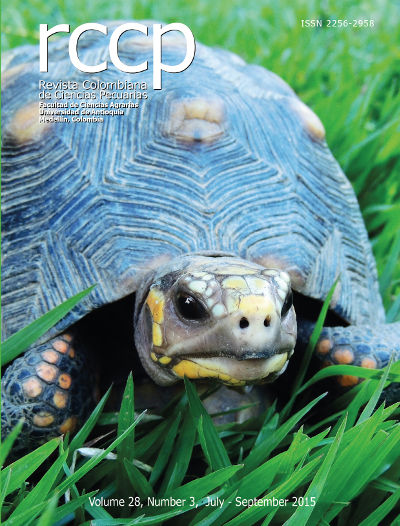Growth and body composition of Midas (Amphilophus citrinellus) and Nile tilapia (Oreochromis niloticus) reared in duoculture
DOI:
https://doi.org/10.17533/udea.rccp.324931Keywords:
behavior, feeding, fish, polycultureAbstract
Background: cichlids are of economical importance either as food (Nile tilapia) or as ornamental fish (Midas) and both exhibit territorialism and aggressive feeding behavior depending on availability of food and space. Objective: to evaluate the growth rates and behavioral changes of Nile tilapia and Midas kept in mono or polyculture. Methods: Midas and tilapia were maintained in a semi-closed rearing system. Initial weight was 0.83 and 0.81 g for Nile tilapia and Midas, respectively. Four treatments with different fish proportions were used. Midas and tilapia were distributed in 12 glass aquaria with three replicates (n = 30 fish per tank). Treatment ratios between Midas and tilapia were 1:0, 1:1, 2:1 and 0:1, respectively. Fish were fed a commercial diet (40% protein, 12% lipids) for six weeks at 5% weight ratio. Feed offer was adjusted weekly. Observations of behavioral traits were recorded throughout the trial to determine social and feeding conduct. Body composition of fish was assessed at the end of the experiment. Results: Midas modified their feeding behavior and their weight gain increased (3.9 ± 0.3 g) in the 2:1 group. The 0:1 group exhibited the lowest growth rate throughout the experiment (2.9 ± 0.3 g). Midas did not affect Tilapia growth (5.8 ± 0.4 g) across treatments. Interspecies aggressiveness was less evident when reared in monoculture (groups 1:0 y 0:1). Intra and interspecies attacks were higher in the 1:1 and 2:1 groups. Proximate body composition indicated higher
lipid levels in Midas across treatments in comparison to tilapia. Conclusions: duoculture benefits growth of juvenile Midas when present at 25-30% of total stocking density with Nile tilapia.
Downloads
References
Antoine T, Wery P, Micha JC, Van Hove C. Comparison of the growth and chemical composition of Oreochromis (tilapia) niloticus and Cichlasoma (Theraps) melanurum Gth. fed with Azolla. Aquaculture 1987; 66:181-196.Abdelghany AE, Ahmad MH. Effects of feeding rates on growth and production of Nile tilapia, common carp and silver carp polycultured in fertilized ponds. Aquac Res 2002;33:415-423.AOAC, Association of Official Analytical Chemists. Official methods of analysis 13th ed. Washington, DC; 1980.Balirwa JS. Ecological, environmental and socioeconomic aspects of the Lake Victoria’s introduced Nile perch fishery in relation to the native fisheries and the species culture potential: lessons to learn. Afr J Ecol 2007; 45:120-129. Barlow GW, Siri P. Polychromatic Midas cichlids respond to dummy opponents: color, contrast and context. Behaviour 1994; 130:77-112. Barluenga M, Meyer A. The Midas cichlid species complex: incipient sympatric speciation in Nicaraguan cichlid fishes? Mol Ecol 2004; 13:2061-2076. Canonicoa GC, Arthington A, McCrary JK, Thieme ML. The effects of introduced tilapias on native biodiversity. Aquat Conserv 2005; 15:463-483.Cruz EM, Laudencia IL. Polyculture of milkfish (Chanos chanosForskal), all-male Nile tilapia (Tilapia nilotica) and snakehead (Ophicephalus striatus) in freshwater ponds with supplemental feeding. Aquaculture 1980; 20:231-237. Da Silva LB, Barcellos LJG, Mezzalira Quevedo R, Guimarães de Souza SM, Kreutz LC, Ritter F, Finco JA, Calliari Bedin A. Alternative species for traditional carp polyculture in southern South America: initial growing period. Aquaculture 2006; 255:417-428.Da Silva LB, Barcellos LJG, Quevedo RM., De Souza SMG, Kessler ADM, Kreutz LC, Ritter F, Finco JA, Bedin AC. Introduction of jundia Rhamdia quelen (Quoy & Gaimard) and Nile tilapia Oreochromis niloticus (Linnaeus) increases the productivity of carp polyculture in southern Brazil. Aquac Res 2008; 39:542-551. Folch J, Lees M, Sloane-Stanley GH. A simple method for the isolation and purification of total lipids from animal tissues. J Biol Chem 1957; 226:497-509. Flood MJ, Noble C, Kagaya R, Damsgård B, Purser GJ, Tabata M. Growing amago and rainbow trout in duoculture with self-feeding systems: implications for production and welfare. Aquaculture2010; 309: 137-142.Gokcek K. Tilapia Oreochromis niloticus (Linnaeus, 1785) and Himri Barbel, Carasobarbus luteus (Heckel, 1843), Duoculture in net cages. J Anim Vet Adv 2011; 10:1102-1105.Hailey A, Chidavaenzi RL, Loveridge JP. Diet mixing in the omnivorous tortoise Kinixys spekii. Func Ecol 1998; 12:373-385.Hernández M, Gasca-Leyva E, Milstein A. Polyculture of mixed-sex and male populations of Nile tilapia (Oreochromis niloticus) with the Mayan cichlid (Cichlasoma urophthalmus). Aquaculture 2014; 418:26-31.Jobling M, Koskela J, Pirhonen J. Feeding time, feed intake and growth of Baltic salmon, Salmo salar, and brown trout, Salmo trutta, reared in monoculture and duoculture at constant low temperature. Aquaculture 1998; 163:73-84.Karakatsouli N, Papafotiou P, Papoutsoglou SE. Mono-and duoculture of juvenile sharpsnout seabream Diplodus puntazzo(Cetti) and gilthead seabream Sparus aurata L. in a recirculated water system. Aquac Res 2006; 37:1654-1661. Martínez-Sánchez JC, Maes JM, van den Berghe E, Morales S, Castañeda EA. Biodiversidad zoológica en Nicaragua. Managua: MARENA PNUD; 2001.McCrary JK, Murphy BR, Stauffer Jr JR, Hendrix SS. Tilapia (Teleostei: Cichlidae) status in Nicaraguan natural waters. Environ Biol Fish 2007; 78:107-114. Papoutsoglou SE, Miliou H, Karakatsouli NP, Tzitzinakis M, Chadio S. Growth and physiological changes in scaled carp and blue tilapia under behavioral stress in mono-and polyculture rearing using a recirculated water system. Aquacult Int 2001; 9:509-518. SAS, Statistical Analysis Systems. Language guide for Personal Computers. Institute Inc. Release 6.03 ed. Cary, NC: SAS institute Inc. 1996.Silva SS, Nguyen TT, Abery NW, Amarasinghe US. An evaluation of the role and impacts of alien finfish in Asian inland aquaculture. Aquac Res 2006; 37:1-17. Vega-R GH. Recurrencia y éxito reproductivo de cíclidos Nicaragüenses en hábitats artificiales. B.Sc. Degree Thesis. Managua:
Rev Colomb Cienc Pecu 2015; 28:255-264Rodríguez GA et al. Tilapia and Midas fish duocultureUniversidad Centroamericana. Facultad de Ciencias Agropecuarias, Departamento de Ecología y Recursos Naturales; 1998.Wang Y, Cui Y, Yang Y, Cai F. Partial compensatory growth in hybrid tilapia Oreochromis mossambicus × O . niloticus following food deprivation. J App Ichthyol 2005; 21:389-393. DOI: https://doi.org/10.1111/j.1439-0426.2005.00648.x
Published
How to Cite
Issue
Section
License
Copyright (c) 2016 Revista Colombiana de Ciencias Pecuarias

This work is licensed under a Creative Commons Attribution-NonCommercial-ShareAlike 4.0 International License.
The authors enable RCCP to reprint the material published in it.
The journal allows the author(s) to hold the copyright without restrictions, and will allow the author(s) to retain publishing rights without restrictions.









